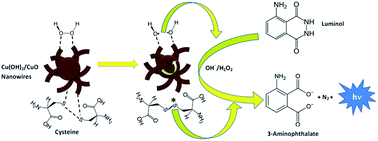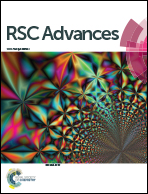Fabrication and characterization of Cu(OH)2/CuO nanowires as a novel sensitivity enhancer of the luminol–H2O2 chemiluminescence system: determination of cysteine in human plasma†
Abstract
This investigation is a novel chemiluminescence (CL) reaction strategy to enhance the inherent sensitivity of the luminol–H2O2 CL system for the determination of cysteine. It was found that CL intensity of cysteine in the luminol–H2O2 system could be enhanced strongly in the presence of our synthesized copper hydroxide/copper oxide nanowires (Cu(OH)2/CuO NWs). About 3–6 fold improvement in the sensitivity was observed when cysteine was determined in the presence of colloidal Cu(OH)2/CuO NWs. Structural, morphological and optical properties of the Cu(OH)2/CuO NWs were examined by X-ray diffraction (XRD), field emission scanning electron microscopy (FE-SEM) and ultraviolet-visible (UV-Vis) spectroscopy. Fourier Transform Infrared Spectroscopy (FT-IR) studies were done to investigate the presence of organic and/or other compounds in the synthesized NWs. In order to explore the CL mechanism, UV-Vis, fluorescence, and CL spectra studies were carried out. It is suggested that the enhancement in the CL intensity of cysteine is due to the fact that luminol, H2O2 and cysteine could be adsorbed on the surface of NWs and all the electron and the energy transfer processes could be facilitated on the surface of NWs. The CL spectra showed that, the luminophor is the excited-state 3-aminophthalate anion (3-AP2−*, the oxidation product of luminol). Moreover, UV-Vis absorption spectra showed that adsorbed cysteine could be oxidized very easy on the surface of NWs and the resulting product along with O2˙− radicals generate more 3-AP2−* anions. Therefore, higher CL intensities could be produced in the presence of prepared NWs. This enhancement effect has not been seen in the CL system of luminol–H2O2–nanoparticles up to now. Based on these findings, a rapid and sensitive assay was developed for the determination of cysteine. Under the optimum conditions, the CL intensity was proportional to the concentration of cysteine in the ranges 0.8 × 10−9 to 8.0 × 10−8 mol L−1 and 8 × 10−8 to 1.0 × 10−6 mol L−1. The limit of detection was 0.69 × 10−9 mol L−1 and percent of relative standard deviations for 50 × 10−9 mol L−1 cysteine (n = 11) was 5.7%. The proposed method was applied successfully for the sensitive determination of cysteine in human plasma and synthesized injection samples.


 Please wait while we load your content...
Please wait while we load your content...